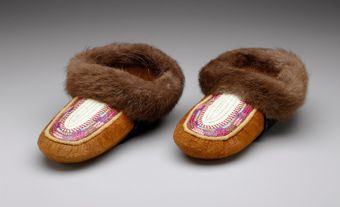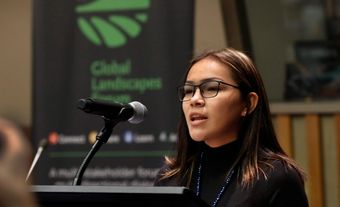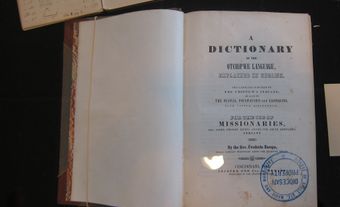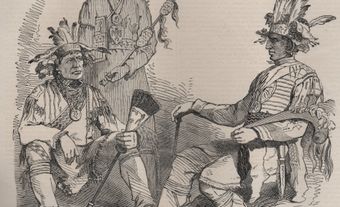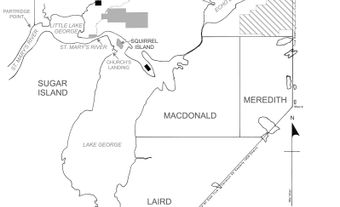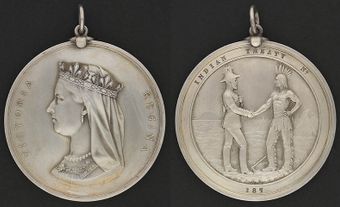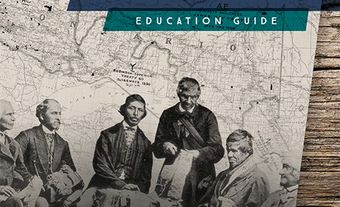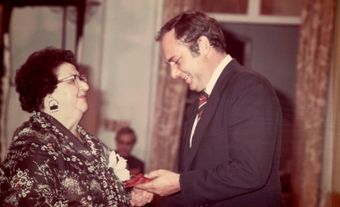Anishinaabe (other variants include Anishinabe, Anicinape, Nishnaabe, Neshnabé and Anishinabek) refers to a group of culturally and linguistically related First Nations that live in both Canada and the United States, concentrated around the Great Lakes. The Anishinaabeg (plural form of Anishinaabe) live from the Ottawa River Valley west across Northern Ontario and to the plains of Saskatchewan south to the northeast corner of North Dakota, northern Minnesota and Michigan, as well as the northern shores of Lakes Ontario and Erie. The Ojibwe, Chippewa, Odawa, Potawatomi, Algonquin, Saulteaux, Nipissing and Mississauga First Nations are Anishinaabeg. Some Oji-Cree First Nations and Métis also include themselves within this cultural-linguistic grouping. ( See also Indigenous Peoples in Canada.)

What Does Anishinaabe Mean?
Anishinaabe is used to describe oneself or a collective group of First Nations peoples belonging to that particular cultural and linguistic family. Individuals use Anishinaabe (or the plural form, Anishinaabeg) to indicate membership and belonging to that group.
Terms for nationalities (e.g.,Ojibwe) and First Nations (e.g., Niisaachewan Anishinaabe Nation) are other identifiers that Anishinaabe people might use to describe themselves. Sometimes people use a combination of these terms (e.g., Ojibwe-Anishinaabeg).
While Anishinaabe is most commonly used to describe Ojibwe people, it can refer to other First Nations that also identify as Anishinaabe. These include, for example, Chippewa, Odawa, Potawatomi, Algonquin, Saulteaux, Nipissing and Mississauga First Nations, as well as some Oji-Cree and Métis. It is important to remember that Anishinaabe is not a synonym for Ojibwe.
Anishinaabe is the Ojibwe spelling of the term. Other First Nations have different spellings. For example, the Odawa tend to use Nishnaabe while the Potawatomi use Neshnabé.
Anishinaabe has deeper, cultural meanings that are often related to origin stories. Elder and linguist Basil H. Johnston maintained that Anishinaabe translates as “Beings Made Out of Nothing” and “Spontaneous Beings.” Some oral traditions also state that the term Anishinaabe originated from anishinaa, which is the first word uttered by the Anishinaabe upon creation. On Manitoulin Island, Anishinaabe is interpreted to mean “Second Man,” which refers to the story of Nanabozo and the great flood. Alternatively, according to an elder from Garden River First Nation in Ontario, Anishinaabe can also mean, “The Men or People Who Live upon the Earth in the Right Way.” Anishinaabe is most commonly translated to mean “Original Man” or the “Good Humans.” (See also Indigenous Oral Histories and Primary Sources.)
Anishinaabe Territories
According to oral histories, the Anishinaabeg originated on the northeast coast of what is now Canada and the United States and migrated to the western shores of Lake Superior. This is sometimes referred to as the Great Migration. Various Anishinaabe communities now exist where people settled along their journey. Subsequent population movements took place after contact with Europeans. This resulted in the Anishinaabeg moving further south into the Ohio Valley and west onto the Plains.

Anishinaabe Language
The Anishinaabe language is Anishinaabemowin and it is spoken in areas generally spanning from Manitoba to Quebec, with a strong concentration around the Great Lakes. In the 2016 census, Statistics Canada counted 35,870 people in Canada who consider Ojibwe-Potawatomi languages (part of the Anishinaabemowin language family) as their mother tongue. (See also Indigenous Languages in Canada.)
Relations with Settlers
During the era of contact, Anishinaabeg became trading partners to Europeans and participated in the fur trade. The Anishinaabeg also participated in major conflicts as allies of the French, English or Americans. This includes the Iroquois/Beaver Wars of 1640, the Seven Years’ War (1756–63), Pontiac’s War (1766) (see also Pontiac), the War of 1812, the Dakota War of 1862 as well as international conflicts in modern history, such as the First World War, Second World War and Korean War. (See also Indigenous-French Relations and Indigenous-British Relations Pre-Confederation.)
As settlement expanded inland, the Anishinaabeg signed multiple treaties with the newcomers. These treaties cover millions of acres of land in Canada and the United States. For example, in 1764, the Anishinaabeg played key roles in the signing of the Treaty of Niagara which established a nation-to-nation relationship with Britain. Land surrender treaties signed by the Anishinaabeg in Canada include all the pre-Confederation treaties in Southern Ontario, the1850 Robinson Treaties, the Manitoulin Island Treaties, Numbered Treaties 1, 2, 3, 4, 5, and 9 as well as the 1923 Williams Treaties. (See also Upper Canada Land Surrenders.) Treaties were also signed in the United States. The various treaties led to the creation of reserves on which many Anishinaabeg continue to reside. (See also Treaties with Indigenous Peoples in Canada.)
The Anishinaabeg, like other Indigenous peoples in Canada, have suffered under assimilationist colonial policies such as the Indian Act and residential schools. In 1895, the Indian Act banned various Indigenous ceremonies and events Residential schools forbade Anishinaabe culture and the Anishinaabe language, Anishinaabemowin. While Anishinaabe culture continues to thrive, such laws and practices have had deep and ongoing political and socio-economic effects on the Anishinaabeg and other Indigenous peoples in Canada. (See also Intergenerational Trauma and Residential Schools.)
Anishinaabe Culture
The Anishinaabe have a vibrant culture. Anishinaabe art forms include birchbark and ash baskets and boxes, which traditionally featured designs made of porcupine quills. ( See also Quillwork.) After contact, the Anishinaabe readily incorporated European trade beads, cloth and other items into culturally based artistic creations. The best example of this is seen in the floral patterns created by many Great Lakes First Nations on moccasins, clothing and bandolier bags.
Anishinaabe artist Norval Morrisseau established the now iconic Woodland Style of Indigenous art. The influential style can be seen in works by Jackson Beardy, Benjamin Chee Chee, Kelly Church, Eddy Cobiness, Blake Debassige and Daphne Odjig. Other Anishinaabe artists include Frank Shebageget, Robert Houle, Bonnie Devine and Katheryn Wabegijig.

Anishinaabe communities have a long tradition of music. Flutes were originally made by young males and used in courtship. Drumming (including hand drumming and powwow drumming) is used for healing and entertainment, and plays a key role in ceremonies. Singing, whether traditional, contemporary or religious, is central to community.
Many Anishinaabe musicians are nationally and internationally well-known, including Leonard Sumner, Crystal Shawanda, Lawrence “Teddy Boy”Houle (died 4 June 2020) and the powwow drum group Bear Creek Singers. (See also Powwow Music and Powwow Singers.)
There are a number of established Anishinaabe writers, such as Drew Hayden Taylor, Richard Wagamese, George Copway, Peter Jones, Leanne Betasamosake Simpson, Waubgeshig Rice, Basil H. Johnston, Niigaanwewidam James Sinclair and Heidi Kiiwetinepinesiik Stark.
Anishinaabeg excel in numerous sports. Some notable examples include hockey players Ted, Jordan and Brandon Nolan, Arron Asham and Melanie Roach, boxer Mary Spencer, rower Marisha Roman, fastball pitcher Darren Zack and Olympic ski jumper Steve Collins.
Other notable Anishinaabe people include diplomat and author James Bartleman, actor Adam Beach, writer and political advocate Catharine Sutton, politician Phil Fontaine, soldiers Tommy Prince and Francis Pegahmagabow, and judge and senator Murray Sinclair.
With the creation of Indigenous studies programs, Anishinaabe students, educators and traditional teachings are increasingly present in classrooms. Some post-secondary institutions are creating culturally and linguistic specific programming. For example, Algoma University, in association with the Shingwauk Kinoomaage Gamig institution located in Sault Ste Marie, Ontario, offers a degree in Anishinaabe Studies. Programs such as this offer culturally relevant courses through an Anishinaabe lens.

 Share on Facebook
Share on Facebook Share on X
Share on X Share by Email
Share by Email Share on Google Classroom
Share on Google Classroom

